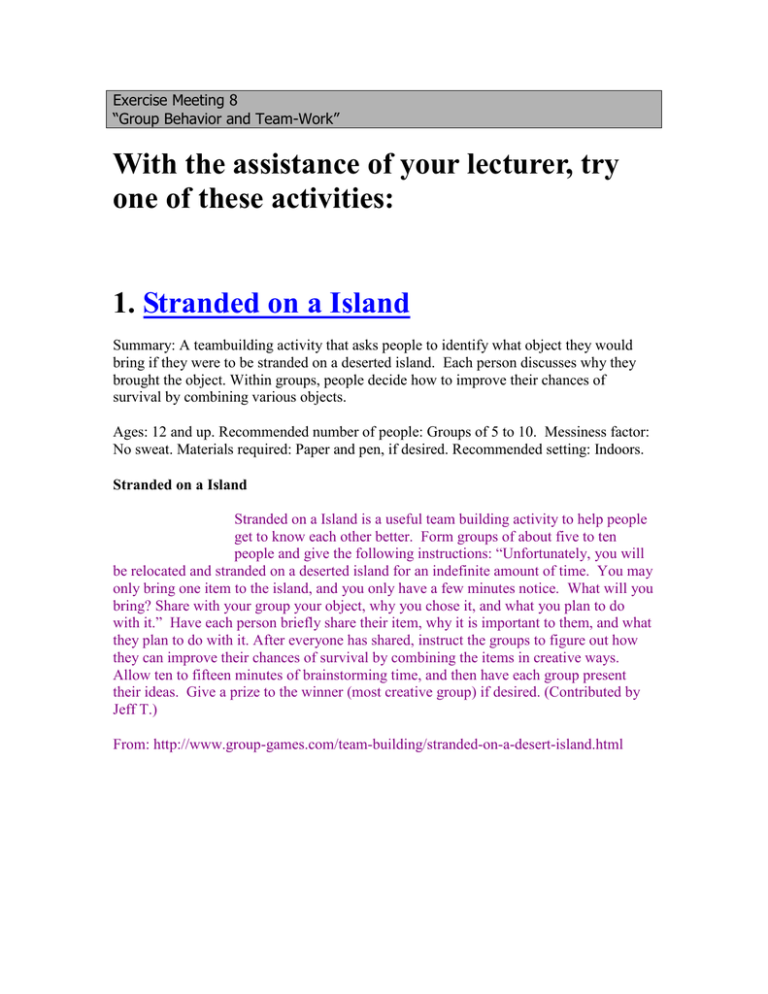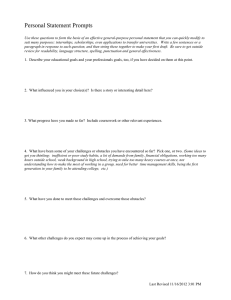With the assistance of your lecturer, try one of these activities: 1.
advertisement

Exercise Meeting 8 “Group Behavior and Team-Work” With the assistance of your lecturer, try one of these activities: 1. Stranded on a Island Summary: A teambuilding activity that asks people to identify what object they would bring if they were to be stranded on a deserted island. Each person discusses why they brought the object. Within groups, people decide how to improve their chances of survival by combining various objects. Ages: 12 and up. Recommended number of people: Groups of 5 to 10. Messiness factor: No sweat. Materials required: Paper and pen, if desired. Recommended setting: Indoors. Stranded on a Island Stranded on a Island is a useful team building activity to help people get to know each other better. Form groups of about five to ten people and give the following instructions: “Unfortunately, you will be relocated and stranded on a deserted island for an indefinite amount of time. You may only bring one item to the island, and you only have a few minutes notice. What will you bring? Share with your group your object, why you chose it, and what you plan to do with it.” Have each person briefly share their item, why it is important to them, and what they plan to do with it. After everyone has shared, instruct the groups to figure out how they can improve their chances of survival by combining the items in creative ways. Allow ten to fifteen minutes of brainstorming time, and then have each group present their ideas. Give a prize to the winner (most creative group) if desired. (Contributed by Jeff T.) From: http://www.group-games.com/team-building/stranded-on-a-desert-island.html 2. Commonalities and Uniquities Summary: A group team-building activity in which people identify common things that everyone has in common, along with interesting characteristics that are unique to a person in the group. Ages: 12 and up. Recommended number of people: Groups of 5-8. Messiness factor: No sweat. Materials required: Two sheets of paper and a pen for each group. Recommended setting: Indoors. Commonalities and Uniquities Form groups of five to eight people and give them two sheets of paper and a pencil or pen. The first part of the activity is Commonalities, where each subgroup compiles a list of the things they have in common. In order for it to make the list it has to apply to everyone in the subgroup. You want to avoid writing things that people can see (e.g. everyone has hair; we are all wearing clothes). You are trying to get them to dig deeper. After about 5 minutes, have a spokesperson from each subgroup read their list. Then, depending on your goals for the session, you can have half of each subgroup rotate to another group for Uniquities or you can leave everyone in the same group. On the second sheet of paper have them record uniquities, meaning that each item applies to only one person in the group. The group tries to find at least 2 uniquities for each person. After 5-7 minutes, you can have each person say one of their uniquities or have a person read them one by one, having others try to guess who it was. (Again, you want to go beyond the superficial, avoiding those things that people can readily see).This is an excellent team-building activity because it promotes unity, gets people to realize that they have more in common than they first might realize. The awareness of their own unique characteristics is also beneficial in that people can feel empowered to offer the group something unique. (Contributed by Amy R.) From: http://www.group-games.com/team-building/commonalities-and-uniquities.html 3. Trust Walk Activity Summary: A team building activity centered around trust. A leader gives verbal or nonverbal instructions to navigate a blindfolded partner to avoid obstacles. Ages: 14 and up. Recommended number of people: Pairs. Messiness factor: Might break a small sweat. Materials required: Blindfolds. Recommended setting: Outdoors, in a location with no dangerous obstacles. Trust Walk Activity The Trust Walk Activity is a team building activity involving leadership and lots of trust as people navigate each other around obstacles.Instructions Find a good location with some obstacles, but nothing dangerous. Some good locations may include the woods or a large field. Form pairs. Ask one partner to be the navigator (guide), and the other to be blindfolded. When the blindfolded partner is ready, slowly spin the person around a few times so that they do not know which direction they are headed. From this point on, the guide should not touch the partnert at all, but rely solely on verbal cues (e.g. “About five steps ahead, there is a branch. Step over it slowly.”) The guide is solely responsible for his or her partner’s safety. He or she should be navigated to avoid obstacles. In this way, participants learn valuable lessons related to teamwork: the guide learns about the challenge and responsibility of caring for another individual’s well being, while the blindfolded partner learns to trust and rely on another person. Ask participants to reflect and share upon their experiences. Sample Questions to Ask During Debrief To help participants reflect and learn upon their experiences, the following are some good sample questions to ask following the Trust Walk team building activity: What do you think is the purpose of this team building activity? What was it like to be the guide, responsible for the safety of your teammates? Did you have any difficulty trusting your partner while blindfolded? Why or why not? Why is trust in your teammates important? How did it feel when you and your teammate successfully trusted each other to accomplish something challenging? How does this relate to _______ (fill in the blank with the current scenario of the participants, such as class, a sports team, employees working together on a project, etc.)? From: http://www.group-games.com/team-building/trust-walk-activity.html




